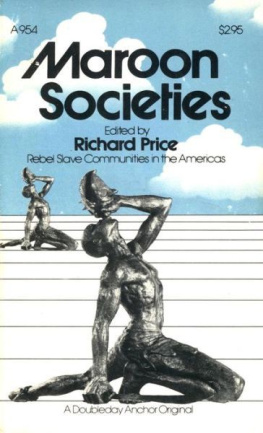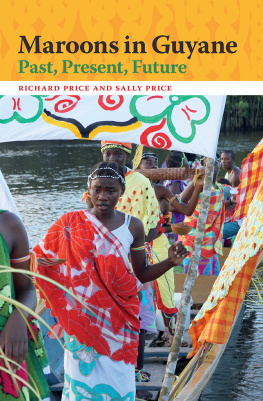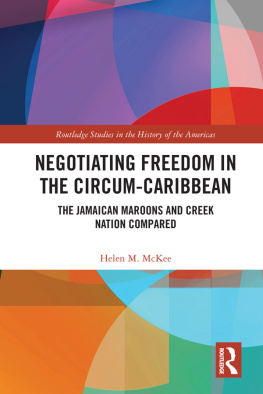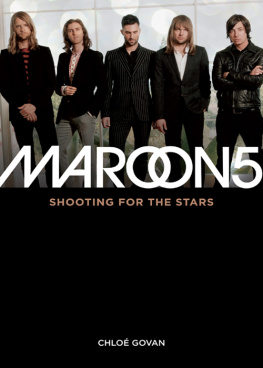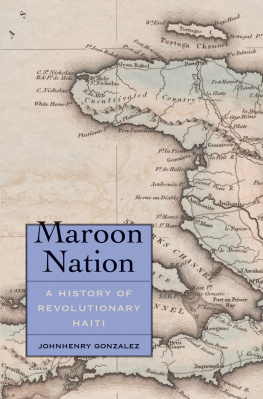
Anchor Books Edition: 1973
eISBN: 978-0-307-82047-1
Library of Congress Catalog Card Number 7383603
Copyright 1973 by Richard Price
All rights reserved
v3.1
TABLE OF CONTENTS
JOS L. FRANCO FRANCISCO PREZ DE LA RIVA DEMOTTCUS PHILALETHES MIGUEL ACOSTA SAIGNES AQUILES ESCALANTE DAVID M. DAVIDSON GABRIEL DEBIEN M. L. E. MOREAU DE SAINT-MRY YVAN DEBBASCH HERBERT APTHEKER R. K. KENT ROGER BASTIDE STUART B. SCHWARTZ BRYAN EDWARDS ORLANDO PATTERSON JOHANNES KING CAPTAIN J. G. STEDMAN A. J. F. KBREN W. VAN WETERING SILVIA W. DE GROOT For the Saramaka, and their children
INTRODUCTION
Maroons and Their Communities
With the fleet of Governor Ovando, bound for Hispaniola in 1502 to reinvigorate the faltering colony that Columbus had left behind the previous year, sailed a few Negroes brought out by their masters (Parry and Sherlock 1965:16). Among them was the first Afro-American maroon, an anonymous slave who escaped to the Indians in the mountainous interior soon after setting foot in the New World (Guillot 1961:77). Today, some 470 years later, there still lives in Cuba a man named Esteban Montejo, who escaped from slavery in his youth and lived for years in the forests, and who must be the last surviving exemplar of this desperate yet surprisingly frequent reaction to slavery in the Americasflight or marronage (Montejo 1968; Salkey 1971).
For more than four centuries, the communities formed by such runaways dotted the fringes of plantation America, from Brazil to the southeastern United States, from Peru to the American Southwest. Known variously as palenques, quilombos, mocambos, cumbes, ladeiras, or mambises, these new societies ranged from tiny bands that survived less than a year to powerful states encompassing thousands of members and surviving for generations or even centuries. Today their descendants still form semi-independent enclaves in several parts of the hemisphere, remaining fiercely proud of their maroon origins and, in some cases at least, faithful to unique cultural traditions that were forged during the earliest days of Afro-American history.
During the past several decades, historical scholarship has done much to dispel the myth of the docile slave. The extent of violent resistance to enslavement has been documented rather fullyfrom the revolts in the slave factories of West Africa and mutinies during the Middle Passage to the organized rebellions that began to sweep most colonies within a decade after the arrival of the first slave ships (see, for example, Herskovits 1958:86109; Mannix and Cowley 1962:10430; Pope-Hennessy 1969; Genovese 1967; Kilson 1964; Moura 1959; Schuler 1970b; and Synnott 1971). And we are finally beginning to appreciate the remarkable pervasiveness of various forms of day to day resistancefrom simple malingering to subtle but systematic acts of sabotage (see, for example, Bauer and Bauer 1942; Blassingame 1972; Bryce-Laporte 1971; Fredrickson and Lasch 1967; and Mintz 1971). Flight or marronage, however, has received much less attention, at least from North American scholarsin part no doubt because so much of the relevant data are in languages other than English but also because publications on maroons and their communities have so often been couched in what Curtin has called the parochial tradition of ethnocentric national history (1969:xv).
Yet maroons and their communities can be seen to hold a special significance for the study of slave societies. For while they were, from one perspective, the antithesis of all that slavery stood for, they were at the same time everywhere an embarrassingly visible part of these systems. Just as the very nature of plantation slavery implied violence and resistance, the wilderness setting of early New World plantations made marronage and the existence of organized maroon communities a ubiquitous reality. Throughout Afro-America, such communities stood out as an heroic challenge to white authority, and as the living proof of the existence of a slave consciousness that refused to be limited by the whites conception or manipulation of it.
From a European perspective, marronage appeared to be the chronic plague of New World plantation societies (Peytraud 1897:373). Within the first decade of most colonies existence, the most brutal punishments had already been reserved for recaptured runaways, and in many cases these were quickly written into law. An early eighteenth-century visitor to Surinam reported that
if a slave runs away into the forest in order to avoid work for a few weeks, upon his being captured his Achilles tendon is removed for the first offence, while for a second offence his right leg is amputated in order to stop his running away; I myself was a witness to slaves being punished this way [Herlein 1718:112, translated in R. van Lier 1971:133].
And similar punishments for marronage from castration to being slowly roasted to deathare reported from many different regions in the selections included in this book.
Yet marronage did not have the same meaning in all colonies at all times. As long as the numbers of slaves who took to the hills remained small, only the least skilled slaves were involved, and they did not interfere directly with plantation life, the maroons existence might be tolerated or largely ignored, as Debien suggests for some of the French islands (1966b:79). Moreover, throughout the Americas, planters seem to have accepted as part of the system the common practice of petit marronage repetitive or periodic truancy with temporary goals such as visiting a relative or lover on a neighboring plantation. For example, temporary flight of this type was clearly an everyday part of plantation life in the southern United States; the pattern is vividly brought to life in several of Faulkners stories (for example, Was, Red Leaves), and is more dryly attested to by Mullins statistics on the motives of Virginia runaways (1972:1089).
It was marronage on the grand scale, with individual fugitives banding together to create independent communities of their own, that struck directly at the foundations of the plantation system, presenting military and economic threats that often taxed the colonists to their very limits. In a remarkable number of cases throughout the Americas, the whites were forced to bring themselves to sue their former slaves for peace. In their typical form, such treatieswhich we know of from Brazil, Colombia, Cuba, Ecuador, Hispaniola, Jamaica, Mexico, and Surinamoffered maroon communities their freedom, recognized their territorial integrity, and made some provision for meeting their economic needs, demanding in return an agreement to end all hostilities toward the plantations, to return all future runaways and, often, to aid the whites in hunting them down (see, for example, Kent 1965:172; Escalante 1954:22629; Franco 1968:100; Debbasch 1961/62:18889; Edwards 1796; Davidson 1966:24950; King 1958). Of course, many maroon communities never reached this stage, being crushed by massive force of arms; and even when treaties were proposed they were sometimes refused (Escalante 1954:22627) or quickly violated (Kent 1965:172; Escalante 1954:229). Nevertheless, new maroon communities seemed to appear almost as quickly as the old ones were exterminated, and they remained the chronic plague, the gangrene, of many plantation societies right up to final Emancipation (Debbasch 1961/62:124).
It is important to keep in mind that maroon societies arose in reaction to colonial slavery, an institution significantly different from that of the ante bellum South, which until recently served so many North American scholars as the implicit model of plantation slavery (see Engerman, et al., 1972). Colonial slave systems in the various parts of the Americas were much more similar to one another at the outset than they were to become later on, after locally born slaves came to predominate, and as whole plantation systems became more differentiated economically, legally, and politically. Early colonial systems shared, for example, a particularly high proportion of native Africans (with all that this implies culturally), a sex ratio heavily skewed in favor of males, and considerable craft specialization among the slaves. As Mullin concluded in a recent study, such factors made colonial slave populations more alike than not and therefore highly comparable (1972:xi). And it is this comparability that is the ultimate justification for a hemispheric approach to maroon societies.
Next page
